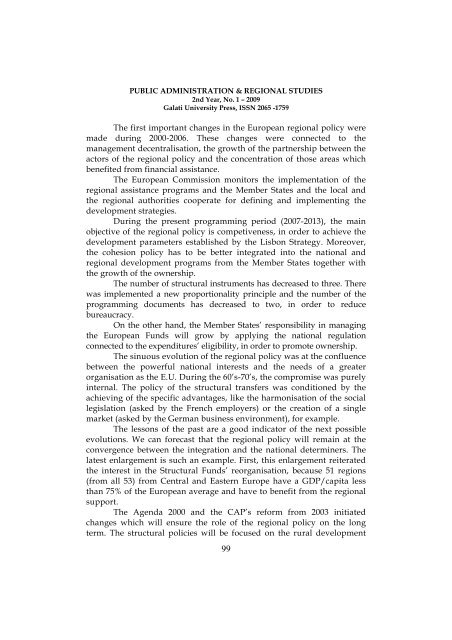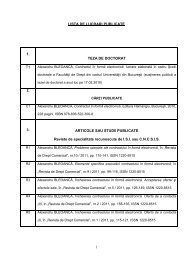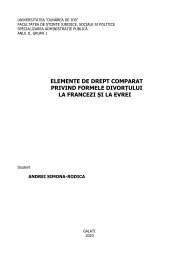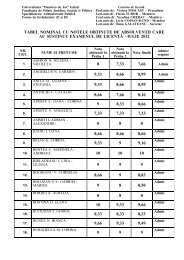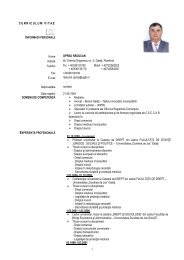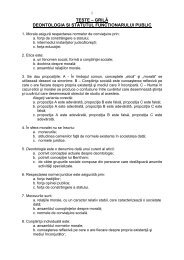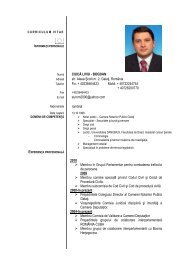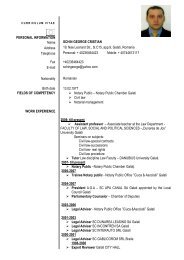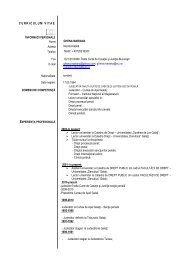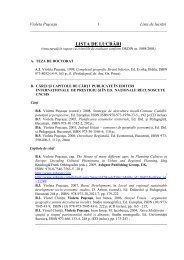regional studies public administration - Facultatea de Drept ...
regional studies public administration - Facultatea de Drept ...
regional studies public administration - Facultatea de Drept ...
You also want an ePaper? Increase the reach of your titles
YUMPU automatically turns print PDFs into web optimized ePapers that Google loves.
PUBLIC ADMINISTRATION & REGIONAL STUDIES<br />
2nd Year, No. 1 – 2009<br />
Galati University Press, ISSN 2065 -1759<br />
The first important changes in the European <strong>regional</strong> policy were<br />
ma<strong>de</strong> during 2000-2006. These changes were connected to the<br />
management <strong>de</strong>centralisation, the growth of the partnership between the<br />
actors of the <strong>regional</strong> policy and the concentration of those areas which<br />
benefited from financial assistance.<br />
The European Commission monitors the implementation of the<br />
<strong>regional</strong> assistance programs and the Member States and the local and<br />
the <strong>regional</strong> authorities cooperate for <strong>de</strong>fining and implementing the<br />
<strong>de</strong>velopment strategies.<br />
During the present programming period (2007-2013), the main<br />
objective of the <strong>regional</strong> policy is competiveness, in or<strong>de</strong>r to achieve the<br />
<strong>de</strong>velopment parameters established by the Lisbon Strategy. Moreover,<br />
the cohesion policy has to be better integrated into the national and<br />
<strong>regional</strong> <strong>de</strong>velopment programs from the Member States together with<br />
the growth of the ownership.<br />
The number of structural instruments has <strong>de</strong>creased to three. There<br />
was implemented a new proportionality principle and the number of the<br />
programming documents has <strong>de</strong>creased to two, in or<strong>de</strong>r to reduce<br />
bureaucracy.<br />
On the other hand, the Member States’ responsibility in managing<br />
the European Funds will grow by applying the national regulation<br />
connected to the expenditures’ eligibility, in or<strong>de</strong>r to promote ownership.<br />
The sinuous evolution of the <strong>regional</strong> policy was at the confluence<br />
between the powerful national interests and the needs of a greater<br />
organisation as the E.U. During the 60’s-70’s, the compromise was purely<br />
internal. The policy of the structural transfers was conditioned by the<br />
achieving of the specific advantages, like the harmonisation of the social<br />
legislation (asked by the French employers) or the creation of a single<br />
market (asked by the German business environment), for example.<br />
The lessons of the past are a good indicator of the next possible<br />
evolutions. We can forecast that the <strong>regional</strong> policy will remain at the<br />
convergence between the integration and the national <strong>de</strong>terminers. The<br />
latest enlargement is such an example. First, this enlargement reiterated<br />
the interest in the Structural Funds’ reorganisation, because 51 regions<br />
(from all 53) from Central and Eastern Europe have a GDP/capita less<br />
than 75% of the European average and have to benefit from the <strong>regional</strong><br />
support.<br />
The Agenda 2000 and the CAP’s reform from 2003 initiated<br />
changes which will ensure the role of the <strong>regional</strong> policy on the long<br />
term. The structural policies will be focused on the rural <strong>de</strong>velopment<br />
99


